Welcome to the ultimate guide for birdwatchers enchanted by the color blue! Utah, with its diverse habitats, is home to a stunning variety of bird species, including some of the most beautiful blue birds in North America.
This guide is not only a comprehensive list of and breeding seasons of the blue birds in Utah, but also includes high-quality photographs to help you identify each blue bird species. Grab your binoculars, download your free photo guide, and get ready to embark on a birdwatching adventure like no other!
Blue Birds Found In Utah
Utah boasts a strikingly diverse landscape, from arid deserts and flat salt plains to high mountain ranges and lush forests. The geographic diversity of Utah is a key factor in its rich avian biodiversity. With habitats ranging from the barren salt flats of the Great Salt Lake to the alpine heights of the Wasatch Range, Utah offers a plethora of unique ecosystems, each with its own set of species.
These conditions make the state a hotspot for birdwatching, especially for those in pursuit of the radiant blue birds that call these varied terrains home. Whether you’re in the red rock canyons of southern Utah or the wetlands of the northern part of the state, you’re in for an unparalleled birdwatching experience.
Western Bluebird
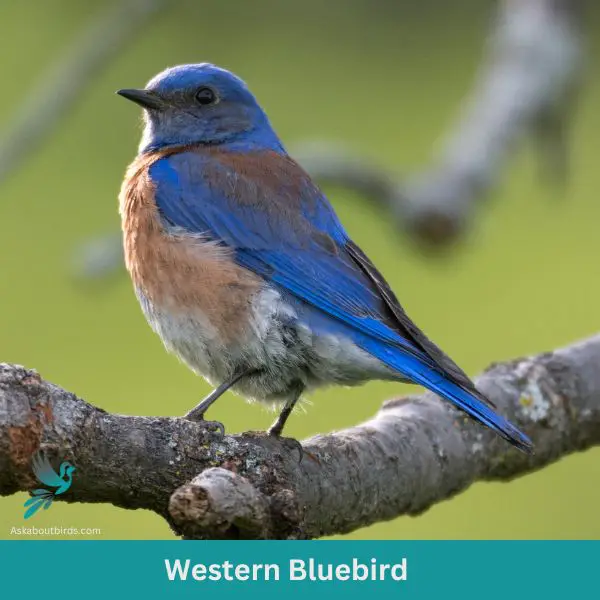
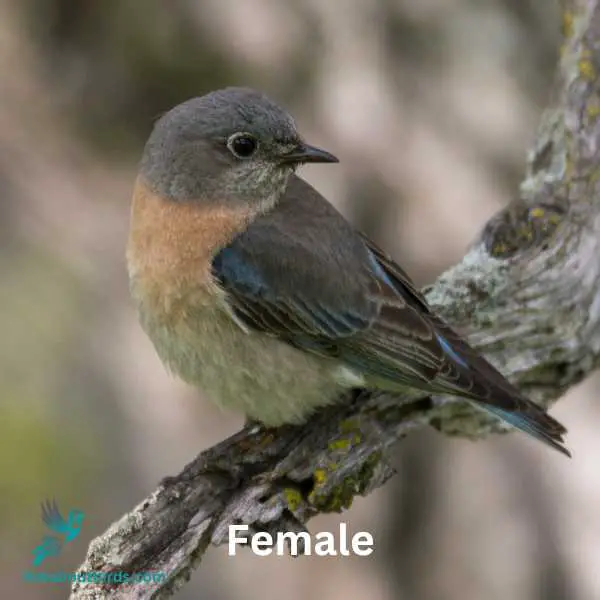
| Trait | Western Bluebird |
|---|---|
| Scientific Name | Sialia mexicana |
| Length | 5.5-7 inches |
| Wingspan | 11-13 inches |
| Weight | 0.8-1.1 ounces |
The Western Bluebird is a charismatic bird, appreciated for its vivid coloring and melodious song, commonly observed in open woodlands and meadows of the West.
Appearance: The male Western Bluebird sports a dark blue head, throat, wings, and tail with an orange breast and sides, transitioning into a grayish belly. Females are more muted, displaying grayish-blue wings and tail with a more subdued orange wash on the chest.
Diet: Western Bluebirds predominantly feed on insects, complemented by berries and fruits when available. They hunt by perching and then diving to the ground to capture their prey, and they’re also known to catch insects in mid-air.
Reproduction: These birds often utilize natural tree cavities or nest boxes for breeding. The female builds a loose nest inside and lays a clutch of 4-6 pale blue eggs.
Mountain Bluebird
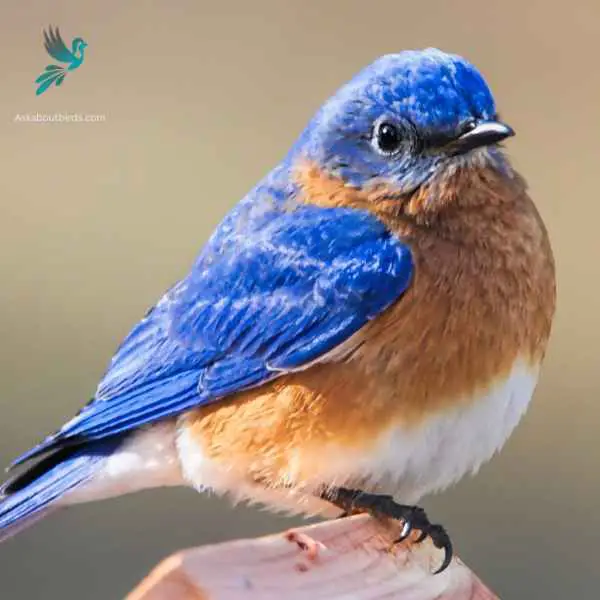
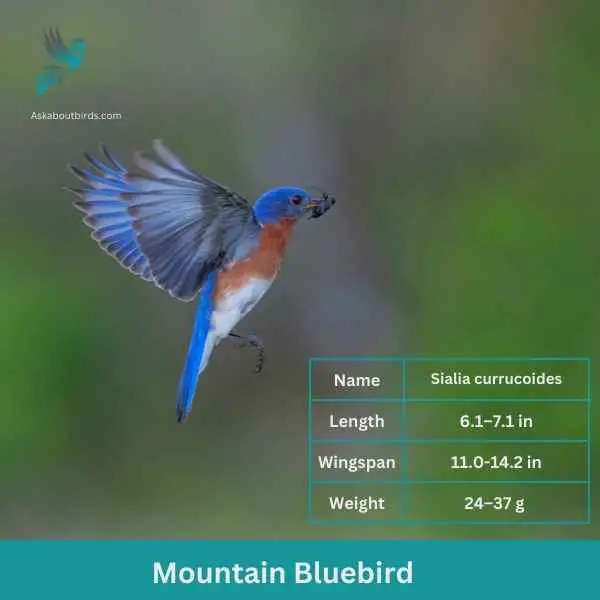
| Feature | Measurement |
|---|---|
| Scientific Name | Sialia currucoides |
| Length | 6.1–7.1 in |
| Wingspan | 11.0-14.2 in |
| Weight | 24–37 g |
The Mountain Bluebird is a small bird found in open grasslands and rocky mountains of North America. It is known for its stunning blue plumage, which is particularly vibrant in males. Females, on the other hand, have a more subdued blue coloration with hints of gray. These birds have slender bodies and a slightly curved bill, adapted for catching insects on the wing.
Mountain Bluebirds are insectivores, feeding primarily on insects such as beetles, grasshoppers, and spiders. They are skilled aerial hunters, capable of capturing their prey in mid-flight. During breeding season, these birds build their nests in tree cavities or man-made nest boxes, where females lay a clutch of eggs. The male bluebird actively participates in nest-building and provides food for the female during incubation.
Steller’s Jay
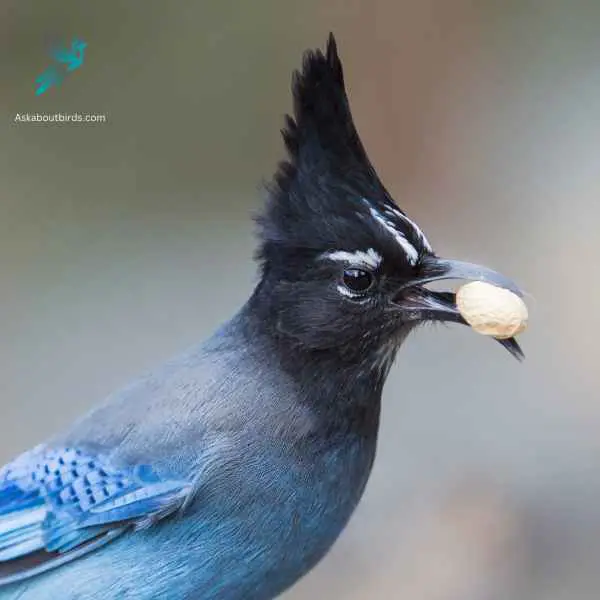

| Feature | Measurement |
|---|---|
| Scientific Name | Cyanocitta stelleri |
| Length | 12–13 in |
| Wingspan | 45 to 48 cm |
| Weight | 45 to 48 cm |
The Steller’s Jay is a charismatic and easily recognizable bird found mainly in the coniferous forests of the western North America, known for its bold behavior and loud, varied calls.
Appearance: The Steller’s Jay has a striking color contrast with a deep blue body and wings and a blackish head and upper body. One of its most distinguishing features is the tall, dark crest on its head, which can be raised or lowered depending on the bird’s mood. Its eyes are dark and its beak is strong and black.
Diet: The Steller’s Jay is omnivorous. It feeds on a wide range of items, from seeds, nuts, and berries to insects and small animals. It’s also known to raid campsites and picnics, often scavenging for human food.
Reproduction: Steller’s Jays form monogamous pairs that often remain together for several years. They typically build their nests in coniferous trees, made from twigs, moss, and other plant materials. The female lays a clutch of 2 to 6 eggs, which are usually pale green or blue with brown spots.
Woodhouse’s Scrub-Jay
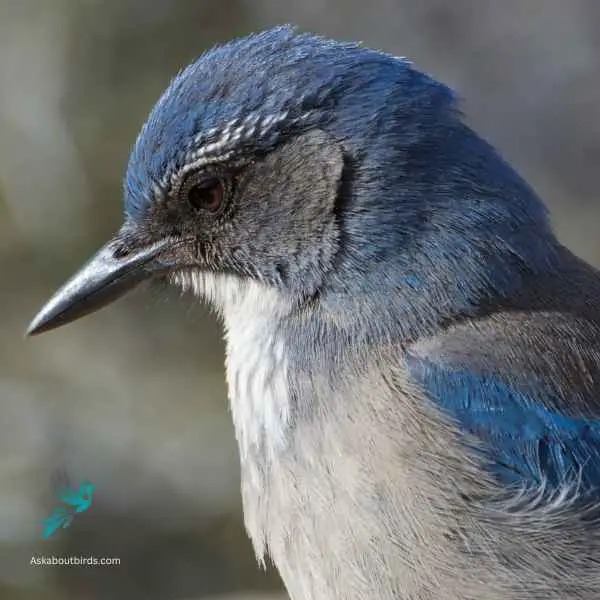

| Feature | Measurement |
|---|---|
| Scientific Name | Aphelocoma woodhouseii |
| Length | 11–12 in |
| Wingspan | 15 in |
| Weight | 80 g |
Woodhouse’s Scrub-Jay is a medium-sized bird that is found in the western part of North America. It has a blue-gray head, wings, and tail, with a brownish-gray back and a white belly. The bird’s bill is black and its eyes are dark. Woodhouse’s Scrub-Jay is known for its loud and harsh calls, which it uses to communicate with other birds in its flock.
This bird is commonly found in arid and semi-arid habitats, such as deserts, scrublands, and oak woodlands. It is an omnivore, feeding on a variety of insects, seeds, fruits, and small animals. Woodhouse’s Scrub-Jay is known for its intelligence and ability to cache food for later use. It is also a territorial bird, defending its territory from other birds and animals. Despite being a common bird, Woodhouse’s Scrub-Jay is threatened by habitat loss and fragmentation, making conservation efforts important for its survival.
Black-Billed Magpie

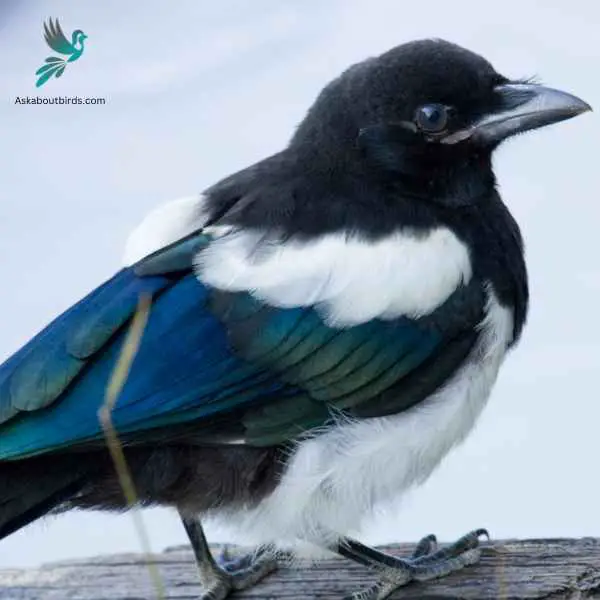
| Feature | Measurement |
|---|---|
| Scientific Name | Pica hudsonia |
| Length | 13.4-15.4 in |
| Wingspan | 27.5-35.4 in |
| Weight | 220-270 g |
The Black-Billed Magpie is a striking bird native to the western half of North America, recognized for its bold black and white plumage and long tail. Its vocalizations are varied, including harsh chatters and melodious notes, and it’s known to be both curious and intelligent.
Appearance: The Black-Billed Magpie has a unique appearance with its glossy black head, chest, and tail contrasting sharply against its white belly and shoulder patches. Its long tail, which is iridescent greenish-blue, is one of its most distinguishing features. The wings also display a hint of iridescent blue-green.
Diet: Black-Billed Magpies are omnivorous and have a diverse diet. They primarily eat insects, especially in summer, but will also consume small mammals, berries, seeds, and carrion. They are often seen scavenging roadkill and are known to store food in the ground for later consumption.
Reproduction: Black-Billed Magpies mate monogamously and usually build large, domed nests in trees or large shrubs. These nests are made from twigs and mud and can be quite elaborate. The female lays a clutch of about 6 to 9 eggs, which are greenish or bluish and speckled with brown.
Common Raven


| Feature | Measurement |
|---|---|
| Scientific Name | Corvus corax |
| Length | 21.3-26.4 in |
| Wingspan | 45-51 in |
| Weight | 0.69 to 2 kgs |
The Common Raven is a large, intelligent bird known for its glossy black plumage and its deep, resonating calls. It has a wide distribution and is often associated with myths and legends in various cultures due to its enigmatic nature.
Appearance: Common Ravens are entirely black, from their robust bills to their shaggy throat feathers. Their eyes are dark, and their wingspan is impressive, often mistaken for a hawk or crow. Both males and females share this appearance, though males are typically slightly larger.
Diet: These birds are highly versatile in their diet, feeding on a variety of foods including small mammals, birds, carrion, fruits, grains, and insects. Their adaptability allows them to exploit various food sources depending on availability.
Reproduction: Common Ravens are monogamous and often form long-lasting pair bonds. They typically build large nests made of sticks, often positioned on cliff ledges or high in trees. The female lays a clutch of about 3 to 7 eggs.
Tree Swallow
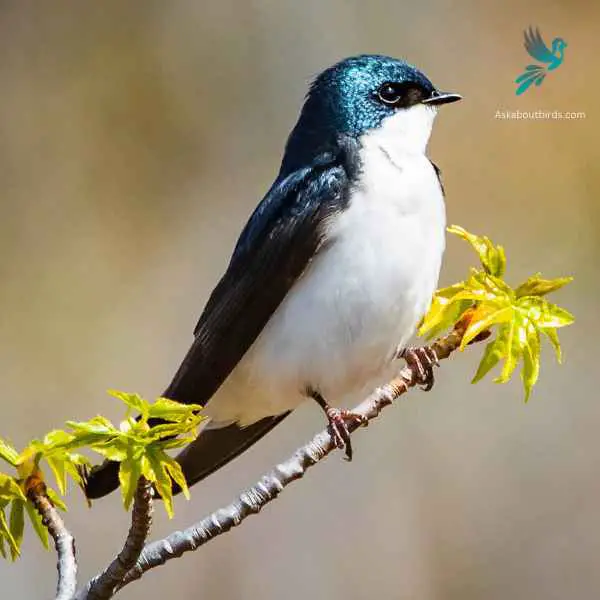
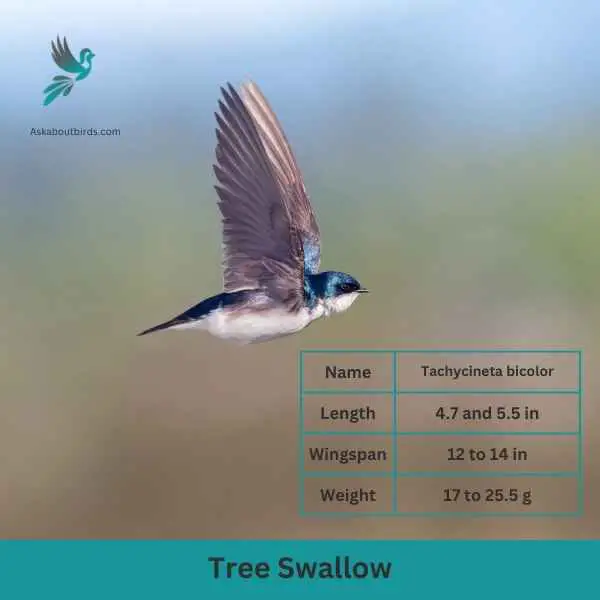
| Feature | Measurement |
|---|---|
| Scientific Name | Tachycineta bicolor |
| Length | 4.7 and 5.5 in |
| Wingspan | 12 to 14 in |
| Weight | 17 to 25.5 g |
The Tree Swallow is a graceful and agile bird, best recognized for its iridescent blue-green upperparts and sweeping flight patterns over open fields and water.
Appearance: The Tree Swallow is sleek with a streamlined body. The upperparts shine with a blue-green iridescence while the underparts are white. They possess long, pointed wings and a slightly forked tail, aiding in their agile flight.
Diet: Tree Swallows primarily feed on flying insects, skillfully catching them mid-air. During colder months when insects are scarce, they can switch to a diet of berries, particularly those of the bayberry, which other birds might find hard to digest.
Reproduction: Tree Swallows are cavity-nesters, typically choosing natural holes in trees or using bird boxes. They line their nests with feathers, creating a soft environment for the eggs. The female will lay a clutch of 4 to 7 white eggs.
Violet-green Swallow
Scientific Name: Tachycineta thalassina
Length: 4.7-5.1 in (12-13 cm)
Wingspan: 9.8-11.4 in (25-29 cm)
Weight: 0.4-0.6 oz (11-17 g)
The Violet-green Swallow is a small, agile bird known for its vibrant coloring and acrobatic flight skills.
Appearance: The male Violet-green Swallow has a bright, iridescent green back and head, and violet-blue wings and tail. The face, sides of the rump, and underparts are white. The female has a similar but duller coloration, with less iridescence on the back and head, and often a brownish tinge on the face and flanks.
Diet: Violet-green Swallows primarily feed on flying insects, which they catch in the air during their acrobatic flights. Their diet includes a wide variety of insects such as flies, wasps, ants, and beetles.
Reproduction: Violet-green Swallows typically nest in tree cavities, building nests, or cliff crevices. They often use old woodpecker holes or nest boxes provided by humans. The female lays a clutch of 4 to 6 white eggs, and both parents take turns incubating the eggs and feeding the chicks once they hatch.
Barn Swallow


| Feature | Measurement |
|---|---|
| Scientific Name | Hirundo rustica |
| Length | 6.5–7.5 in |
| Wingspan | 12.5–13.5 in |
| Weight | 16–22 g |
The Barn Swallow is a sleek, agile bird renowned for its graceful flight patterns and iconic forked tail, often seen darting over fields and water bodies in search of flying insects.
Appearance: Barn Swallows have deep blue, almost iridescent, upperparts and a rufous to tawny underbelly. Their distinctively forked tail and long wings give them a streamlined look. Both males and females have a similar appearance, though males often exhibit slightly brighter colors and a deeper fork in the tail.
Diet: Barn Swallows feed primarily on flying insects, which they catch in mid-air during their agile and acrobatic flights. Their diet includes flies, beetles, moths, and other small flying insects.
Reproduction: Barn Swallows are known for building their mud nests on man-made structures, particularly barns, bridges, and eaves. The nest is cup-shaped and made from mud pellets, often lined with feathers. The female lays a clutch of 4 to 6 eggs.
Belted Kingfisher

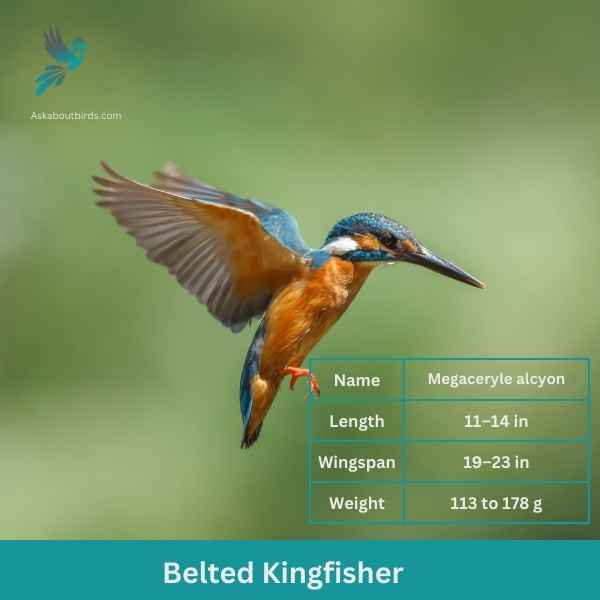
| Feature | Measurement |
|---|---|
| Scientific Name | Megaceryle alcyon |
| Length | 11–14 in |
| Wingspan | 19–23 in |
| Weight | 113 to 178 g |
The Belted Kingfisher is a distinctive and easily recognizable bird, frequently observed near water bodies, where it can be seen diving headfirst to catch prey.
Appearance: Sporting a prominent crest, the Belted Kingfisher has a slate blue-gray upper body and white underparts. Males possess a single blue band across their white chests, while females have an additional rufous band, making them one of the few bird species where females are more brightly colored than males. Their bill is long, sharp, and dagger-like.
Diet: As expert fishers, Belted Kingfishers mainly prey on small fish, but they’ll also consume crustaceans, insects, and amphibians. They’re known for their hunting tactic of hovering over water, spotting their prey, and then diving swiftly to snatch it.
Reproduction: Belted Kingfishers nest in burrows which they excavate in sandy or earthen banks, usually adjacent to water. The tunnel can be anywhere from 3 to 6 feet long, ending in a chamber. Within this chamber, the female lays a clutch of 5 to 8 white eggs.
Indigo Bunting


| Feature | Measurement |
|---|---|
| Scientific Name | Passerina cyanea |
| Length | 4.5–5.1 in |
| Wingspan | 7.1–9.1 in |
| Weight | 11.2–21.4 g |
The Indigo Bunting is a strikingly vibrant songbird, often hailed for its brilliant blue plumage and melodic song that graces woodlands and meadows during the warmer months.
Appearance: Males are renowned for their bright indigo blue feathers, which can appear darker in certain lights. Females and juveniles, on the other hand, are brown with subtle hints of blue on their wings and tail. The species lacks the vibrant streaking or spotting commonly found in many other songbirds.
Diet: Indigo Buntings primarily subsist on seeds, especially during non-breeding seasons. During the breeding season, they also consume a variety of insects such as beetles, caterpillars, and spiders, providing essential protein for their growing chicks.
Reproduction: Indigo Buntings build their nests close to the ground in shrubs or low tree branches. These nests, crafted meticulously with grasses and other plant materials, cradle clutches of typically 3 to 4 eggs. After hatching, the young are fed by both parents until they’re ready to fledge.
Lazuli Bunting
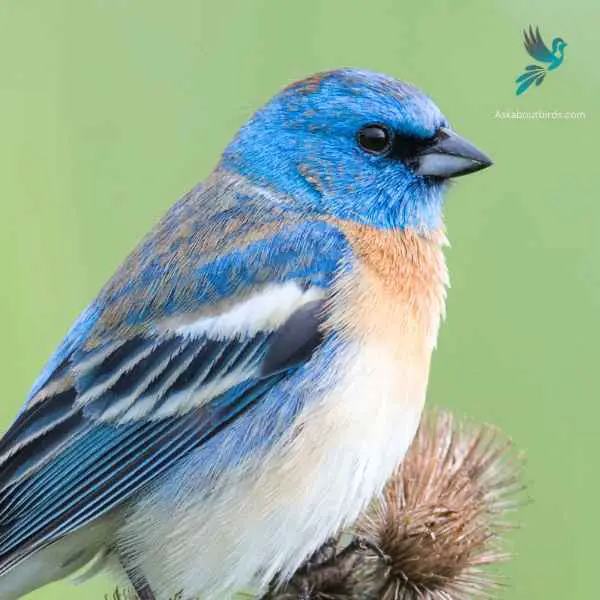

| Feature | Measurement |
|---|---|
| Scientific Name | Passerina amoena |
| Length | 5.1-5.9 in |
| Wingspan | 8.7 in |
| Weight | 13-18 g |
The Lazuli Bunting is a vibrant songbird recognized for its brilliant colors and melodious song, frequently seen in brushy areas and woodlands during the summer months.
Appearance: The male boasts a dazzling bright blue head and back, offset by a white belly and rust-orange breast. Females and immature birds present a more muted brownish hue overall, with a hint of blue on the wings and tail.
Diet: Lazuli Buntings primarily feed on seeds, but during the breeding season, they’ll also consume insects. Their strong, conical beaks are perfectly adapted for seed-cracking.
Reproduction: The female Lazuli Bunting constructs a cup-shaped nest using grasses, twigs, and other fine materials, often placing it in a shrub or low tree. She typically lays a clutch of 3-4 pale blue or white eggs.
Blue Grosbeak
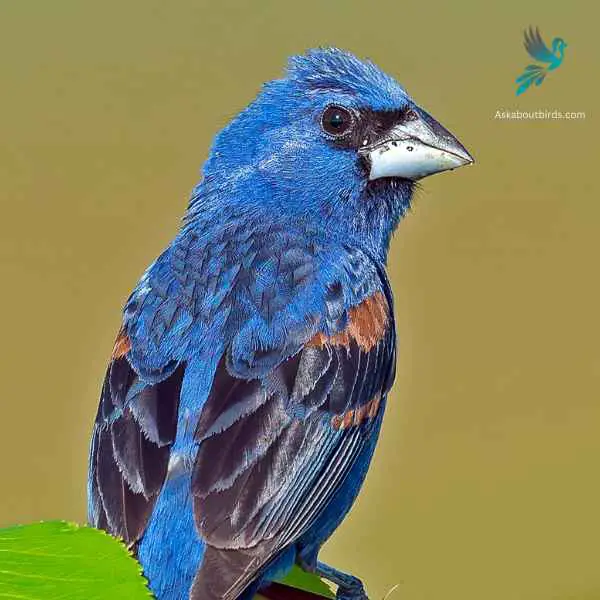

| Feature | Measurement |
|---|---|
| Scientific Name | Passerina caerulea |
| Length | 5.5 to 7.5 in |
| Wingspan | 10 to 11 in |
| Weight | 26 to 31.5 g |
The Blue Grosbeak is a medium-sized songbird found in North and Central America. The male Blue Grosbeak displays stunning plumage with deep blue feathers on its body and head, while the female has more subdued brownish tones. Both sexes have a thick, conical bill, which gives them their name “grosbeak,” meaning large beak.
These birds prefer open habitats such as grasslands, brushy areas, and woodland edges. Blue Grosbeaks are known for their melodious songs, which consist of a series of rich and varied notes. They primarily feed on seeds and insects, using their strong beaks to crack open seeds and forage on the ground or in low vegetation.
Where to Spot Utah’s Blue Birds
From the rugged canyons to the serene wetlands, Utah offers an array of stunning locations for birdwatching. Here are the top spots where you can find an astonishing diversity of birds, including the captivating blue species.
- Bear River Migratory Bird Refuge: Located in northern Utah, this refuge is a paradise for waterfowl and shorebirds. It’s one of the best places to spot the Tree Swallow, along with other blue-hued birds.
- Zion National Park: The dramatic cliffs and lush valleys of Zion create a habitat that’s conducive for both mountain and desert bird species. The blue birds here include Western Bluebirds and Mountain Bluebirds.
- Antelope Island State Park: This island in the Great Salt Lake is more than just a scenic getaway—it’s also an excellent place for birdwatching. From Blue Jays to various swallows, you’ll find several shades of blue here.
- Fish Springs National Wildlife Refuge: Situated in the western desert, Fish Springs offers a surprising range of habitats and bird species. The area is perfect for spotting blue birds like the Belted Kingfisher.
- Canyonlands National Park: Known for its deep canyons carved by the Colorado River, this park offers a unique blend of desert and river habitats. Keep an eye out for the Blue Grosbeak during your visit.
| Neighboring States | Best Spots for Blue Birds |
|---|---|
| Arizona’s Blue Birds | 1. Grand Canyon National Park 2. Saguaro National Park 3. Chiricahua Mountains |
| Colorado’s Blue Birds | 1. Rocky Mountain National Park 2. Mesa Verde National Park 3. Pawnee National Grasslands |
| Idaho’s Blue Birds | 1. Coeur d’Alene National Forest 2. Sawtooth National Recreation Area 3. Boise River Wildlife Management Area |
| Wyoming’s Blue Birds | 1. Yellowstone National Park 2. Grand Teton National Park 3. Medicine Bow National Forest |
| Nevada’s Blue Birds | 1. Great Basin National Park 2. Red Rock Canyon 3. Lake Tahoe Basin |
| New Mexico’s Blue Birds | 1. Bosque del Apache National Wildlife Refuge 2. Gila National Forest 3. Carlsbad Caverns National Park |
FAQs on Blue Bird Species Found in Utah
What is the habitat of the Black-throated Blue Warbler?
The Black-throated Blue Warbler typically inhabits deciduous forests in the eastern half of North America, particularly in areas with a dense understory. During the breeding season, they can be found in Canada’s southern provinces and the northeastern United States. In the winter, they migrate to the Caribbean and Central America. Their preferred habitat includes a mix of mature trees and shrubs, as the dense undergrowth provides cover and foraging opportunities. Interestingly, the habitat preferences of the male and female Black-throated Blue Warblers differ slightly, with males preferring areas with denser understory vegetation and females occupying areas with more open understory.
What is the difference between a Blue Jay and a Western Scrub Jay?
The Blue Jay and the Western Scrub Jay are two distinct species of birds that belong to the same family, Corvidae. The Blue Jay (Cyanocitta cristata) is commonly found in the eastern and central regions of North America, while the Western Scrub Jay (Aphelocoma californica) is found in the western regions of North America, particularly in areas with open woodlands, scrublands, and suburban areas. Both species have a blue crest, white chest, and gray belly, but the Blue Jay has a distinctive black necklace and brighter blue plumage, whereas the Western Scrub Jay has a more subdued blue color and lacks the necklace.
Do Eastern Bluebirds visit bird feeders?
Eastern Bluebirds are primarily insectivorous and usually catch their food in flight or forage on the ground. However, they will occasionally visit bird feeders, particularly in winter when insects are less abundant. They are attracted to feeders that offer mealworms, suet, or fruit. If you want to attract Eastern Bluebirds to your bird feeders, it is recommended to provide mealworms in a shallow dish or a platform feeder. Also, maintaining a natural habitat with scattered trees and open spaces will make your yard more attractive to them.
What are the common features of bluebird species?
Bluebird species typically share several common features. They are medium-sized birds with rounded wings, bright blue plumage, and a somewhat contrasting belly color, which is often gray or white. Most bluebird species have a light blue to sky blue color on their backs and wings, with some having darker blue or even bluish-gray on their heads and backs. Their throats are usually white or light-colored, and some species also have brown markings or white chests. They prefer open habitats with scattered trees or pine trees and usually nest in cavities, like a woodpecker hole or a nest box. Bluebirds are bold birds, often seen perching in open areas or flying across fields.

